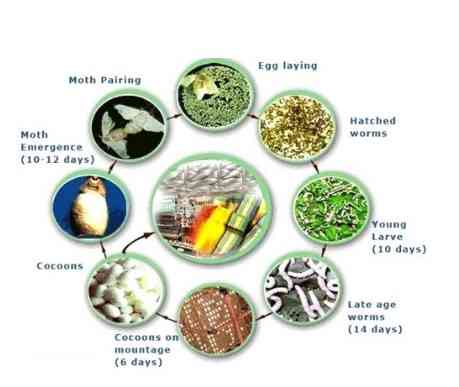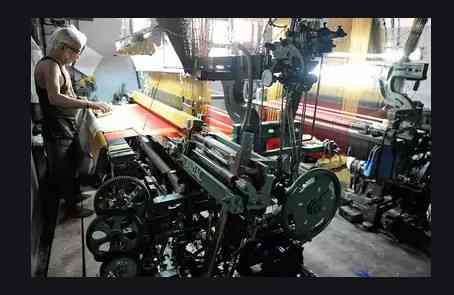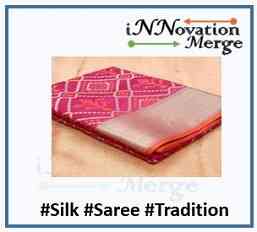For Feedbacks | Enquiries | Questions | Comments - Contact us @ innovationmerge@gmail.com
Origin of Silk
- The production of silk originates in China in the New stone age (Yang Shao culture, 4th millennium BC). Chinese lady His-Ling –Shin is credited with the introduction of Sericulture & invention of loom in about 3000 BC.
Introduction of silk in India
- The archaeological discoveries in Harappa and Chanhu-daro suggest that sericulture (Cultivation of Silkworm is known as sericulture), employing wild silk threads from native silkworm species, existed in South Asia during the time of the Indus Valley Civilization while hard and fast evidence for silk production.
- India is the second largest producer of silk in the world after China. About 97% of the raw mulberry silk comes from six Indian states, namely, Andhra Pradesh, Karnataka, Jammu and Kashmir, Tamil Nadu, Bihar and West Bengal.
- India is the only country to produce all five known commercial varieties of silk (Mulberry, Tropical Tasar, Oak Tasar, Eri, and Coral). Most of the Mulberry silk variety is produced in the country.
Process of Making Silk:
- The silkworm survives only for two or three days and the most unique thing is that at the same time, after every sexual contact, female silkworm insulates 300-400 eggs on the leaves of the mulberry tree.
- In a span of 10 days, each and every egg produces a small female insect called larvae also known as Caterpillar. Then in approximately 30 to 40 days, growth takes place, larvae become long, sloppy and magnified.
- Now continuously for three days this insect spins his head around it and forms the solution of a single long thread which is known cocoon. Cocoon is a protective case or shell that the silkworm spins around it.
- As soon as it comes in contact with the air, this thread solidifies and a silk thread which is about 1000 meters long is formed. Now, these larvae are converted into a pupa.
- In the pupa stage, the larval structures of the silkworm are broken down forming adult structures and the caterpillar gets transformed into a moth.
- The cocoon helps the worm to stay protected from the harsh and unfriendly weather conditions. Usually, the insects spin a cocoon around them at the start of winter and spend the entire season inside the cocoon without the need for food and water. This stage is often referred to as the sleeping stage of the silkworm.
- Usually, in 12 to 15 days, Pupa becomes a silkworm by transplantation, with the help of an alkaline secretion cut the cocoon from one side and comes out. This makes the silk thread of cocoon broken into small pieces.
- Therefore, to obtain silk, the cocoon is put into the boiling water, so that the silkworm which is inside died there and segregates thread from it. In this way, Silk is prepared from Silkworm. And further, this silk is used in the manufacture of clothes.

Process of weaving Silk sarees:
Design Making:
- The most important and creative process in weaving a saree is its designing. Once the design to be woven is finalized (hand drawn or digitally produced). It is translated to designing software, inch wise. The process is called “Likhai” and done by the designer, locally known as “Nakshaband”. The naksha carefully designed and precise, acts as a blueprint to be hand punched on cardboard stencils called “Naksha Pattas”. The higher the number of grids which translate to an inch of the fabric, the greater is the resulting intricacy and level of weaving complexity.
- Naksha Pattas are linked in a chain-like structure and attached to the jacquard loom. The cards collectively form the mechanism required to lift the necessary yarns during the process to weave a motif and help translate the pattern in the fabric. A couple of hundred to even a couple of thousands of graphing cards can be required in weaving depending on the design of the saree.. A bigger size and large number of naksha pattas define a more complex pattern
Materials:
- The procurement of raw materials and verifying their usability is the next important step. The process starts with the selection of the silk yarn, which is of various qualities and imported from various production centers. Raw silk is specially treated for brocades and the process requires considerable patience and labor. The cost of raw materials varies depending upon the type of yarn and zari chosen.
Reeling:
- In the process of reeling (tying the yarn in a bundle), the threads are separately mounted on the reeling machine, for the warp (tana) the yarn is rolled on a shuttle (dharki). The yarn for weft (Bana) is firstly mounted on a charka and then rolled on the bobbin.
Dyeing:
- Dyeing of yarn in a particular color usually involves immersing the reel or cheese of yarn in the dyeing tank.
Weaving:
- The most complicated part of the whole process is weaving, where the sari is woven on a handloom or power loom. Traditionally, sarees are woven on jacquard pit looms .The tana (warp), the longitudinal threads, are held in tension on the loom and lifted up. The bana (weft), the latitudinal threads, are placed in a shuttle. As the shuttle moves back and forth, the warp and weft threads are interwoven.
Iterations:
- Choosing and balancing colors in a pattern, or “Meena-Matching” as we like to call it, is an integral part of our design process and perhaps, one of the most significant determinants of the overall aesthetic appeal of a woven textile.
- Once a pattern has been designed, graphed with a certain number of colors in mind, and set up on the loom, individual colors are carefully chosen for each element. A swatch is then woven to assess the selections. After several iterations and engaging discussions between the design and weavers, a beautiful saree emerges.
Finishing:
- Depending on the weaving technique employed, Sarees need to go through the final process of cutting. This involves manually cutting the tiny threads left on the reverse of the fabric . The sarees are then folded and packaged.


